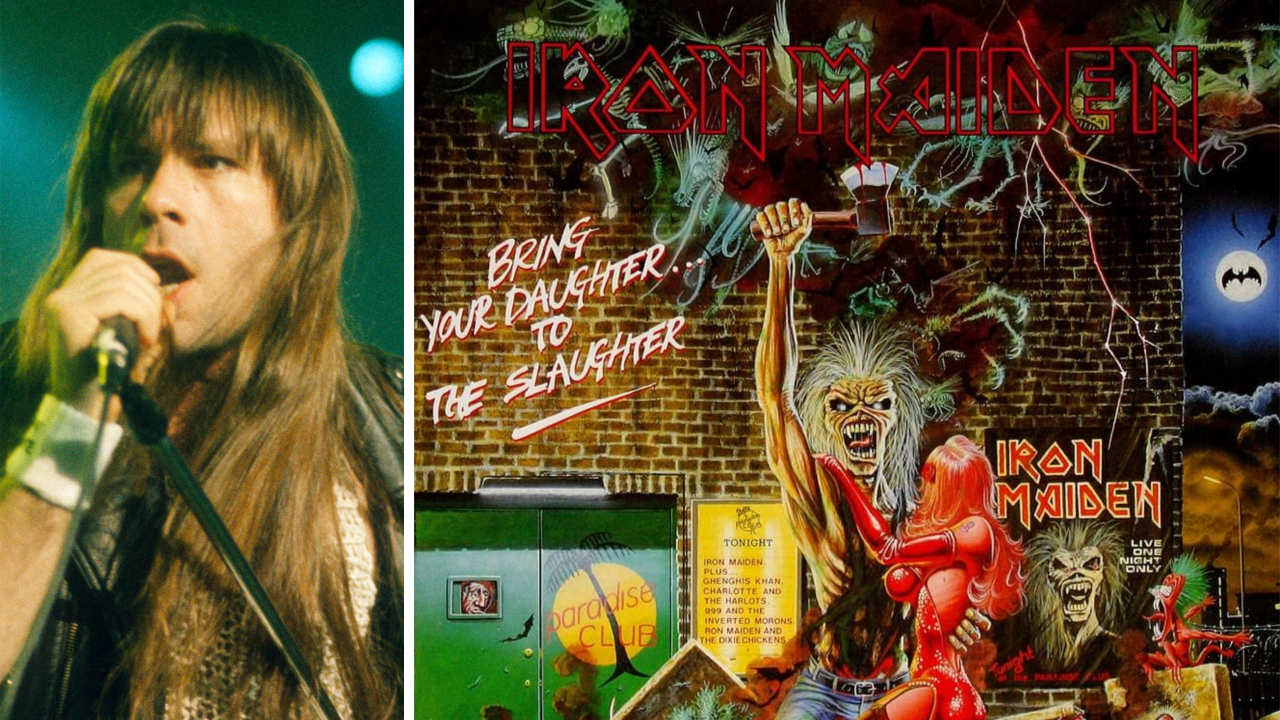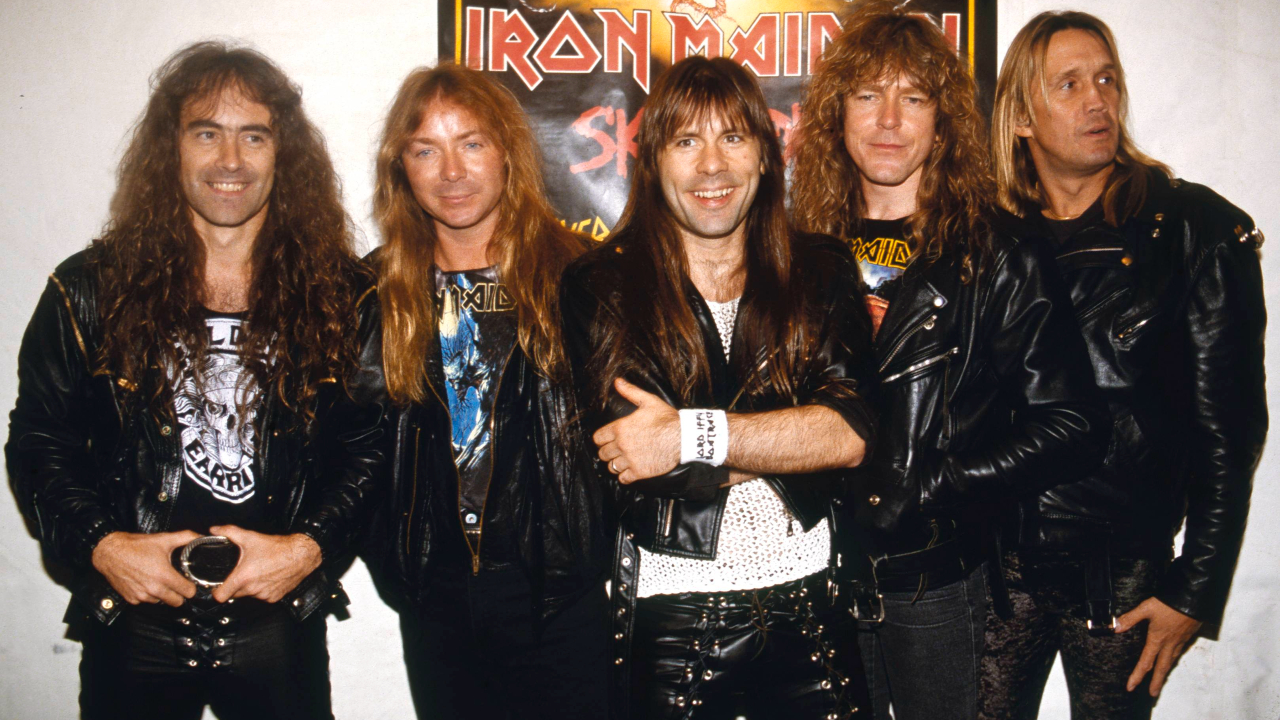“The BBC showed one minute and 10 seconds of it!” Bring Your Daughter To The Slaughter: How a banned, censored and divisive song became Iron Maiden’s only UK number one single
Despite a BBC ban, winning a “Worst Original Song” award and being pulled from the band’s setlist, Bring Your Daughter To The Slaughter remains Iron Maiden’s sole UK chart-topping single

Iron Maiden have one of the most enviable back-catalogues in all of heavy metal. Having released music for upwards of 40 years now, The Beast’s repertoire includes such all-time classics as Run To The Hills, Fear Of The Dark, Can I Play With Madness and The Trooper. However, not one of these live mainstays and critical darlings has ever made it to the coveted number one spot in the UK singles chart. The only Maiden track to have that honour is one that’s since divided fan opinion and been expelled from their setlist: Bring Your Daughter To The Slaughter.
Daughter… is proper meat-and-potatoes metal. Eschewing the majestic melodies and literature-inspired topics normally associated with top-shelf Maiden, it’s instead a four-minute anthem about, well… bringing your daughter to the slaughter. It was the second single off of the band’s most contentious album, 1990’s No Prayer For The Dying, and its ability to find mammoth success at what’s been called Bruce Dickinson and the boys’ creative nadir has given it a complicated legacy to say the least. We at Hammer once even published an op-ed called “Why you should love Bring Your Daughter To The Slaughter even though it’s crap”.
Daughter… was never supposed to be an Iron Maiden song, mind. Frontman Bruce originally wrote the sleazy and violent rocker as his first solo outing, spurred by an invitation to appear on the soundtrack of 1989’s A Nightmare On Elm Street 5: The Dream Child. Maiden manager Rod Smallwood got the call but, with the rest of the lineup either enjoying downtime or working on the Maiden England live album, it was Bruce that leapt at the chance.
“[Rod asked if I had] anything kicking about,” he said in Mick Wall’s 1998 Maiden biography Run To The Hills. “I was like, ‘Yeah, definitely!’ – you know, lying.”
Needing a musical collaborator, the frontman approached his old mate Janick Gers, who’d later join Maiden as a guitarist in 1990. For now though, Bruce wanted to do something that wasn’t possible in that band: something seedy and grungy, at direct odds with the grand, progressive stylings flaunted on then-latest album Seventh Son Of A Seventh Son. “Bruce called me and I went round to see him, and he brought out this song that sounded AC/DC-ish,” Janick remembered in Run To The Hills.
Daughter… came together incredibly quickly. Bruce says he wrote the lyrics “in about three minutes”, with the chorus – ‘Bring your daughter! Bring your daughter! To the slaaaaaaaughter!’ – dripping in that “AC/DC-ish” simplicity while also embodying the campy horror intrinsic to the Nightmare… franchise. The entire thing then took only two days to record.
When released on Nightmare 5, Daughter… didn’t exactly make a seismic splash. The film was only a moderate box office success, overcoming fiercely critical reviews to make $22 million against an $8 million budget, and the soundtrack didn’t enjoy much notice. The most attention it got was from the Golden Raspberry Awards (basically the Oscars, except for shit stuff), where Daughter… won the Worst Original Song trophy in 1989.
Sign up below to get the latest from Metal Hammer, plus exclusive special offers, direct to your inbox!
Two key parties adored the track, though. The first was the higher-ups at Zomba, the label group that released the Nightmare 5 soundtrack: their demand for more material eventually led to Bruce’s debut solo album, Tattooed Millionaire. The second was Maiden’s bassist and founder, Steve Harris. “Steve heard the song and just loved the song so much that he said I had to record it with Maiden,” Bruce told Let It Rock in 2001.
In fact, Steve adored the less flighty tone of Daughter… so much that it dictated the direction of the then-upcoming No Prayer… album. Furthermore – although Seventh Son… was a smash in the UK, reaching number one in the album charts – the bassist had been annoyed by the lack of goodwill in the US, where the metal scene was dominated by more aggressive-sounding youngsters like Metallica and Megadeth. The decision was made to go grottier, so he hired the Rolling Stones’ mobile studio to record after writing the album in just a couple of weeks. This perceived rush contributed to guitarist Adrian Smith’s dissatisfaction and eventual exit (he was replaced by Janick just before recording), as well as the critical panning the album got upon release.
Nonetheless, No Prayer… reached number two in the UK and Daughter… springboarded off of that momentum when released as a single on Christmas Eve 1990. It became the band’s – and heavy metal’s – first UK number one single six days later, staying atop the chart as the new year dawned.
Daughter… overcame some strong opposition to become the biggest song in the country. For starters, it was denied a place on the BBC Radio 1 playlist – likely due to the violent title and lyrics.
“I don’t think [the song] even exists in [the BBC’s] universe,” Bruce said during a 1991 appearance on Tonight With Jonathan Ross. “They were probably choking on their briar pipes when it came out.”
The music video was also heavily edited when broadcast on Top Of The Pops. The footage showed a Maiden performance intercut with scenes from 1960 horror The City Of The Dead, starring Sir Christopher Lee. Although the film was in the public domain, the briar pipe smokers must have found the clips, once again, highly objectionable, despite them actually being rather tame.

“They showed one minute and 10 seconds of a song that’s [four] and a half minutes long,” Bruce said on Tonight. “The BBC obviously thought there was too much cowabunga going on, so they decided to edit it themselves, and then everybody else on telly [did the same as] a knee-jerk reaction.”
However, all this censorship actually helped thrust Daughter… to number one. The song was released during the festive season in response to English crooner Cliff Richard eyeing a Christmas number one with Saviour’s Day. It was the dark reaction of a silent majority to all that saccharine crap.
Plus, in a 2007 retrospective on No Prayer…, BBC journalist Sid Smith called the ban “credibility-restoring”. The furor echoed what had happened with Maiden’s best-selling album, 1982’s The Number Of The Beast, where widespread condemnation from religious fundamentalists only made the band seem cooler to their target audience.
“The kids who did wanna buy our records were like, ‘Oh cool! The religious right are burning their records! I better buy half a dozen!’” Bruce said of the Number… fiasco in 2005 documentary Iron Maiden: The Early Days – and the same principle applied to Daughter….
The single then became a setlist regular during the rest of Bruce’s stint with the band. Yet, when the singer left to more fully pursue his solo career in 1993 and got replaced by Blaze Bayley, Maiden intentionally dropped it from their gigs due to its close association with their then-former frontman. It’s remained a rarity since, even following Bruce’s 1999 return, only getting aired during the 2003 Give Me Ed ’Til I’m Dead tour.
Quite why Daughter…’s still in the scrapheap of Iron Maiden’s live songs has never been clearly explained, but the ongoing controversy around it likely plays its part. Even today, for every social media comment calling the song a masterpiece, there’ll be another deeming it an overly basic entry in the band’s otherwise bombastic and adventurous canon. No matter which side of the fence you fall on, however, there’s no denying that Daughter… briefly lifted Iron Maiden to the very top of the commercial mountain – not just in metal, but all of music.


Louder’s resident Gojira obsessive was still at uni when he joined the team in 2017. Since then, Matt’s become a regular in Metal Hammer and Prog, at his happiest when interviewing the most forward-thinking artists heavy music can muster. He’s got bylines in The Guardian, The Telegraph, The Independent, NME and many others, too. When he’s not writing, you’ll probably find him skydiving, scuba diving or coasteering.
